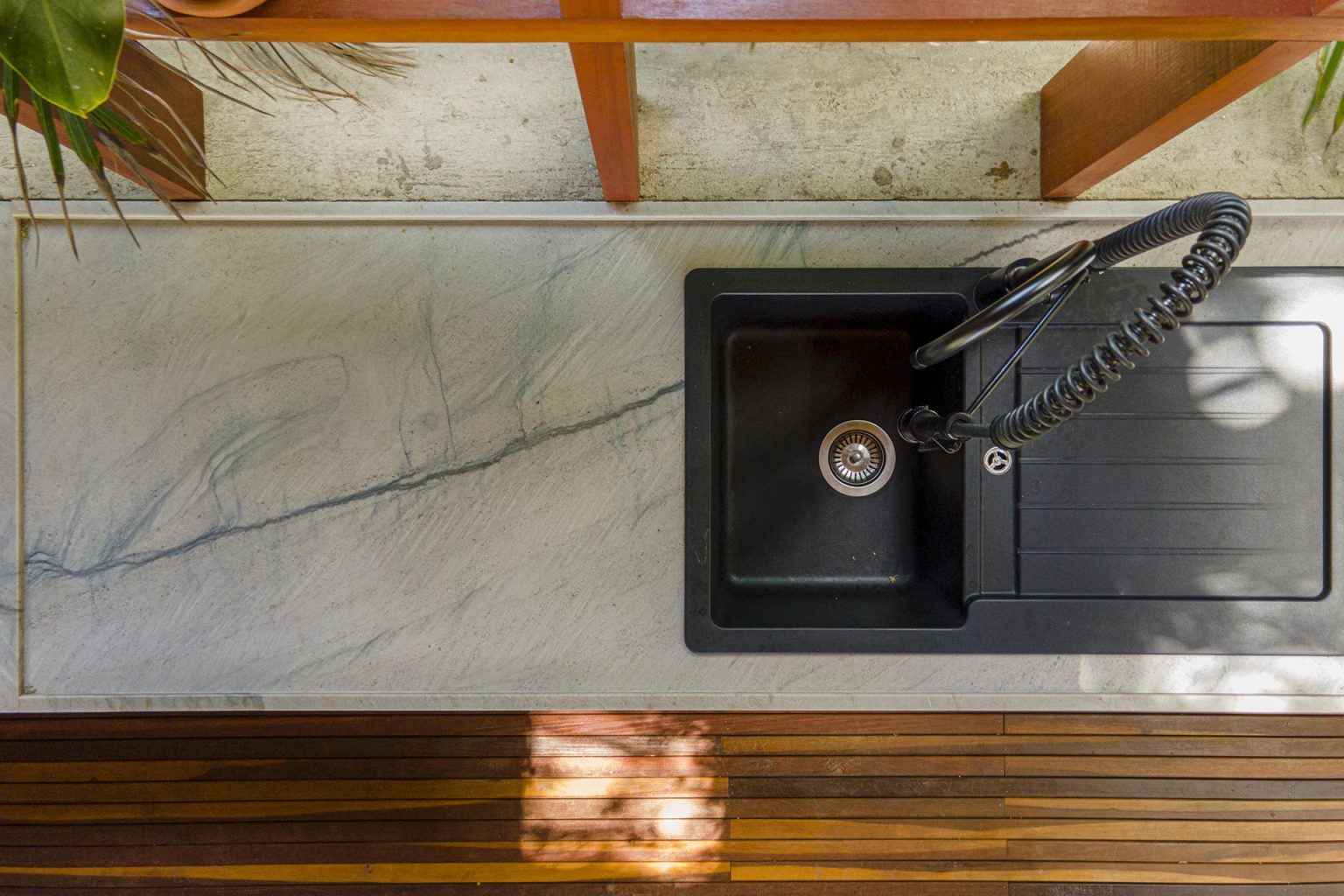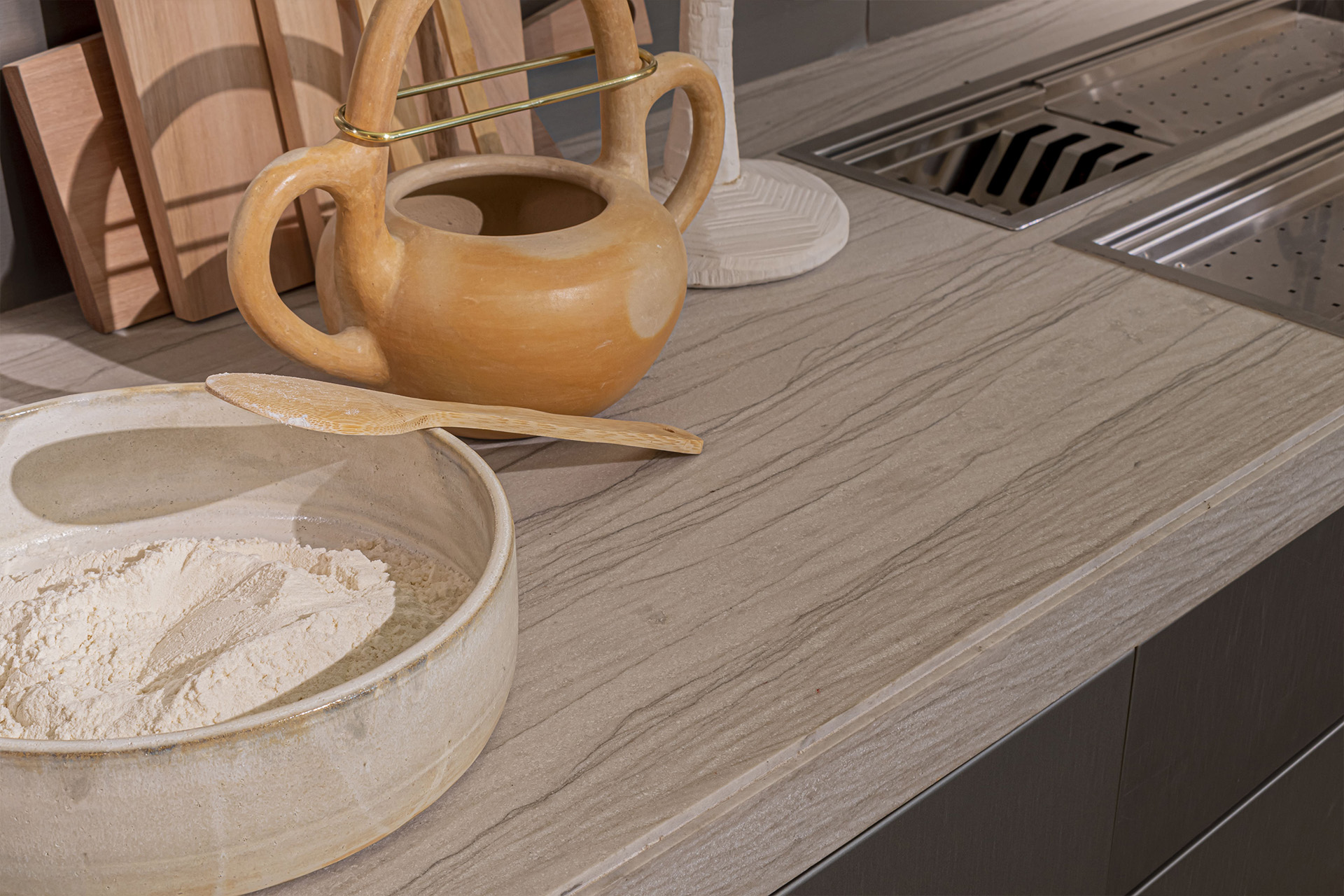Kitchen countertops
It amazes us that there was a time when the kitchen was a hidden area of a house, relegated to housekeeping and stocking food and cleaning products.
Nowadays a kitchen can be a joyful and collaborative place where people meet to share more than just a meal, but special moments. They were extended, invaded balconies and decks, and were integrated with the living room and, sometimes, even with the entire house.
Speaking of which, the Imovelweb portal, in 2020, showed that comparing the same period between 2019 and 2020, there was a 163% growth in the search for properties with a gourmet balcony. Houses have been, for some time now, designed to be large and with integrated areas, islands, and large and fluid countertops, which allows easy handling and especially for people to be together in the act of cooking and enjoying the kitchens.
Countertops coverings, in this context, can be a great asset, integrating the area with harmony or becoming the star, with their colors and textures.
For us, the most important thing, however, is the need for these coverings to have durability and high performance in terms of the care required for their maintenance. The kitchen, most of the time, is one of the first rooms that people interact with during the day, so it is a place where people tend to want to be comfortable and unrestricted for their “start for the day” routine.
So here are 5 tips on how to choose the ideal stone for your kitchen.
⦁ First step: understand how you want to use and live with the countertop.
Without a doubt, this is the first thing you need to think about when choosing coverings for kitchen countertops. Is it a kitchen for everyday use or a kitchen for occasional use? Is it where you want to cook in a group and enjoy a drink with friends while making dinner? Will the children interact directly with the countertop? And will pets, which have definitely joined families and are part of the household routine, have access to this space?
Here our priority will be choosing natural stones as a reference, based on all that points, whether you need a low-performance stone or just decorative, with numerous restrictions, or a super stone, such as crystalline quartzites, which do not react when in contact with acids, and have very high resistance to scratches and stains.
There are several types of stones in the market from the most diverse places in the world and from different discourses that lead the customer to choose between one and the other, but, in our opinion, comfort and tranquility of being able to live the space always come first. No worries about the lemon juice that dripped, the meat that splattered blood, or the wine that was spilled.
⦁ Are Lemon drips allowed or no dripping at all? Choose a stone that has high acid resistance.
A kitchen for everyday use will undoubtedly constantly interact with products with some level of acidity: lemon, orange, vinegar, tomato, olive oil, or wine. In this regard, silicate stones such as quartzites or similar stones in terms of technical characteristics are unsurpassed.
Carbonate stones such as calcitic marble, dolomitic marble, or limestones are reactive to acidity, losing their luster when in contact with acid — sometimes for a few minutes, sometimes for a few hours. And this “loss of shine” is not something merely aesthetic, this reaction literally corrodes the stone, creating an altered surface that is rougher than the rest of the countertop.
And what is the impact of that on the countertop? Roughness on the surface of the stone causes a high capacity for dirt to adhere, literally staining the corroded area. Besides, when looked at against the light, the alteration of the material is notorious. The relevance of this in everyday life in a house is the limitation of use or the constant worry, the acceptance of stains, or the exchange, and even more importantly, the right choice of covering from the beginning of the project.
In this regard, the market for non-carbonated natural stones — keep in mind that the group of carbonate stones is composed of marbles and limestones in their most diverse types — has a huge range of options nowadays, geologically speaking, in addition to the classic granites, which are now very trendy in new, much more contemporary outfits, but, this is the subject of another blog post, crystalline quartzites and a mega family of stones that have similar behavior to quartzites, such as cataclasites, metabreccies, trachytes, cherts, metaconglomerates, itabirites, and even an offshoot of quartzites.
Yes, the ornamental stones sector had to find itself within geology regarding the market’s favorite, the quartzites, to help provide information to specifiers and users regarding the two typologies currently in vogue. Crystalline quartzites and sandy quartzites, which are in terms of mineralogy the same thing, in terms of absorption can take the user from heaven to hell, we will cover this in the next topic.
Finally, if you want to have a free, light, and happy life with your kitchen countertop, run away from carbonate stones, and embrace silicates, whether they are granites, quartzites, cherts, or whatever, they will give you a quality of life that maybe you never even imagined existing in a natural product in a space as emblematic as the kitchen.
⦁ Stains: how the percentage of absorption and porosity of your stone will interfere with your well-being.
Indices such as absorption, porosity, density, resistance to bending, compression, freezing and thawing, abrasion wear rates, and many others are part of any stone. These indices permeate the decision on which stone will be used in high-traffic equipment, such as shopping malls and airports, and special demand, such as hospitals and laboratories.
In everyday life, however, when choosing the stone for the kitchen countertop, for example, when looking at staining, the two most important points will be the porosity of the absorption percentual. Porosity is basically the percentage of empty spaces in the stone that is directly related to the rock formation process. Here, the igneous and metamorphic ones are the champions, of course, not in their entirety, but very well represented by stones such as granites, quartzites, some shales, and a huge variety.
The absorption percentage of a stone, in turn, is precisely the percentage of water that a stone absorbs precisely because of the number of voids it has and this is what will determine how much you will have to worry about avoiding stains when using your kitchen countertop. These indices are determined in tests carried out in laboratories with accreditation for this and the stone specifiers will most likely have documents that present them.
In general, ABNT recommends using stones with a porosity percentage lower than 1% and an absorption percentage lower than 0.40%. The stones, conceptually, are nothing more than an agglomeration of one or more minerals that, as in the alchemy of cooking, are aggregated to form something different, from the stones, and with that, each one aggregates differently according to the forming minerals, the conditions of stone formation, such as temperature, pressure, and time, which will be decisive in this transformation.
But, take note: don’t try to focus on understanding how old a stone is, what is its petrographic name, all the indices of each one, what will have relevance is what it absorbs over time, 24 hours is an excellent clock, 48 hours, 72 hours and 96 hours — the time that laboratories use to know about the alterability of a stone — answer all the demands of a house.
In general, make sure that the marble manufacturer you work with is fully aware of how the stones that are being specified and chosen to behave. If in doubt, contact the supplier with their help or even directly, if you want, carry out tests, the important thing is to understand the demand for waterproofing the stones, yes, some of them will reach their maximum performance with only them.
And be aware that, some of them, especially within the group of quartzites, sandstones, and granites, will only achieve this excellence with waterproofing products. True comfort can only be achieved with crystalline quartzites like Perla Santana in which waterproofing is just an extra care.
⦁ Mechanical strength. Can the knife touch my countertop?
What determines the strength of a stone is its mineralogy and its formation, keeping in mind that a stone is an aggregate of minerals that, depending on how they are “mixed” in nature, becomes more or less resistant.
The hardness of minerals is determined by tests and some scales present them to the “scholars” of the subject. One of the most popular is the Mohs hardness scale, created in 1812 by the German mineralogist Friedrich Vilar Mohs, which has a unit growth scale ranging from 1 to 10 as a reference. On the Mohs scale, the least hard mineral is talc, which receives a hardness value of 1, while the hardest mineral found in nature to date is diamond, which has a hardness value of 10.
But this hardness grows exponentially and, with that, diamond is actually 1,500 times harder than talc. Below is an infographic that shows this more clearly.
Looking at everyday stones, a marble, no matter if calcitic or domolytic, will not have a hardness greater than 4 on the Mohs scale, which, in absolute hardness, will be around 21, while good quality granites with 30% to 40% quartz, with more or less 50% feldspar they will have their hardness between 6 and 7. That is, between 72 and 100 in absolute hardness.
Quartzites, which have predominantly quartz in their formation, will basically have more than 90% of this mineral, in other words, their absolute hardness is in the order of 100, which means 4 to 5 times more resistant than any marble.
And in real life, what impact does the Mohs hardness scale have on my specification, or choice of stone for my kitchen?
The danger is literally in the knives! Stones with an average hardness below 7 can scratch with knives, while stones with a hardness below 5 can scratch with glass, that is, marbles and limestones do not have mechanical resistance to scratches either from knives or other kitchen utensils. Another important thing, the “dragging” of pans and other utensils, there is always dust and sand that are sometimes even suspended in the air, and fatally there is a residue of dust on the countertops, the sand (that little grain like the one on the beach) for your information is quartz, so with a marble or limestone countertop, for example, if you put a pan or a plate on top of it and drag, it will scratch.
With granite, however, a similar stone, or with quartzite, this problem will not happen.

⦁ Colors, a rainbow in the form of natural stones at your disposal.
Again, quartzites made it possible to have a super range of colors between the stone typologies themselves, with true quartzites or stones that technically behave like them.
Their biggest advantage when compared to granites is the distribution of colors, which is not concentrated as in pigments as with granites, they are diluted in tones many times within the same color along the stones or even in veins. And the most beautiful thing about it is that these movements, these nuances, are witnesses of the history of stone formation.
Colors such as white, beige, grey, red, green, brown, and black, are all possible with very high-performance stones without having to resort to synthetics, using natural stones.
We recently heard from an architect that “life is too short not to have a pink kitchen”, at that moment, we understand that there is no need to be prejudiced in choosing the color of the kitchen, everyone can choose according to what they feel in that moment of their life, without thinking that they might get sick of the color in the future. If you do get sick of it in the future, just change! It’s a great opportunity to give your life an upgrade.
If you want to know some of the colors that make up our portfolio, you can find them below or just follow us on social media.




